
Introduction
This year we've seen the arrival of something
pretty different in the desktop monitor market. Widescreen monitors have been
around for many years, with 16:10 formats gradually now being phased out in
favour of new 16:9 format screens. Large 24" and 27" screens are becoming the
norm, but now a few manufacturers have decided to experiment with a new option
for widescreen experiences. Dell are one of the first to release a new 21:9
aspect ratio screen in a pretty massive 29" size. The screen is classified as
super-widescreen or panoramic, but offers a 2560 x 1080 resolution and a big
area in which to work. This seems to be an interesting new idea, providing an
attractive option for movies and gaming, and also for side by side multi-tasking,
perhaps being a decent replacement for some dual-screen setups.
The U2913WM forms part of Dell's new 2013 line-up
of UltraSharp screens and is the first 29" model they have released, and also
the first super-widescreen offering. The "W" suffix signifies this Widescreen
nature, while the "M" signifies it is a standard 16.7 million colour screen
(like the U2312HM, U2412M, U2713HM etc). The screen even carries some of Dell's
new high-end features including an AH-IPS panel, factory calibration and a
uniformity compensation feature. We've also reviewed the new
27" U2713H (16:9 aspect) screen recently.
The Dell marketing states: "Experience
the panoramic 29" (73cm) Dell UltraSharp U2913WM, featuring 2560 x 1080 Full
HD, versatile connectivity and innovative productivity features. Enjoy precise
colours calibrated at the factory to support more than 99 percent sRGB colour
space at a delta-E of less than 5."


Specifications and Features
The following table gives detailed information
about the specs of the screen:
|
Monitor
Specifications |
|
Size |
29"WS (73.02 cm) |
Panel Coating |
Light
Anti-glare (matte) |
|
Aspect Ratio |
21:9 |
Interfaces |
1x Dual-link DVI (HDCP), 1x DisplayPort 1.2,
1x Mini DisplayPort 1.2, 1x HDMI, 1x D-sub |
|
Resolution |
2560 x 1080 |
|
Pixel Pitch |
0.265 mm |
Design
colour |
Matte black bezel and stand |
|
Response Time |
8ms G2G |
Ergonomics |
Tilt,
swivel, 130mm height |
|
Static Contrast Ratio |
1000:1 |
|
Dynamic Contrast Ratio |
2 million:1 |
VESA Compatible |
Yes, 100mm |
|
Brightness |
50 to 300 |
Accessories |
DL-DVI cable, Power cord, USB 3.0 upstream cable, Mini DP to DisplayPort cable,
Cable Tie, Factory Calibration Report |
|
Viewing Angles |
178/178 |
|
Panel Technology |
AH-IPS |
Weight |
With stand and cables: 8.34 Kg |
|
Backlight Technology |
W-LED |
Physical Dimensions |
(WxHxD with stand - max height)
699.8 x 487.0 x 194.2 mm |
|
Colour Depth |
16.7m (8-bit) |
|
Refresh Rate |
60Hz |
Special
Features |
4x
USB 3.0 ports, Audio out, Factory calibration sRGB mode, uniformity correction, touch sensitive controls, PbP |
|
Colour Gamut |
Standard Gamut
72% NTSC (CIE 1931), >99% sRGB coverage |
Manufacturers website link:
Dell
The U2913WM offers a very good range of video
connections which is great to see and something which Dell have always done a
good job with on their UltraSharp models. There are D-sub, HDMI, Dual-link DVI,
DisplayPort and now Mini DisplayPort provided for video interfaces. It's nice to see HDMI provided for
users who want to connect other devices, particularly external Blu-ray and DVD
players. The digital interfaces are HDCP certified for encrypted content as
well. There is also an audio out connection for connecting headphones / external
speakers if you wish to take the sound from the HDMI or DisplayPort inputs.
There are no integrated stereo speakers on this model although the screen is
compatible with Dell's SoundBar if you wish.
The screen comes packaged with a dual-link DVI and
DisplayPort > Mini DisplayPort cables which is useful although there is no
normal DisplayPort or HDMI cable provided with the screen unfortunately,
presumably due to cost saving measures. The screen has an internal power supply
and so you only need a standard kettle lead (provided) to power the screen.
There is a 4-port USB 3.0 hub provided as well, with 2 ports on the back and 2
ports on the left hand side of the screen. The USB cable to connect back to your
PC to power these ports is provided in the box. Unlike some of the other Dell
models (U2713H and U2711 for instance) there
is no card reader on this model unfortunately which personally I find useful. The screen also has
Dell's new
uniformity correction technology which we will
test later on
as well. This didn't seem to do much at all
on the U2713H so it will be
interesting to see if it helps on the U2913WM.
Below is a summary of the features and connections
of the screen:
|
Feature |
Yes / No |
Feature |
Yes / No |
|
Tilt adjust |
 |
DVI |
 |
|
Height adjust |
 |
HDMI |
 |
|
Swivel adjust |
 |
D-sub |
 |
|
Rotate adjust |
 |
DisplayPort |
 |
|
VESA compliant |
 |
Component |
 |
|
USB Ports |
 |
Composite |
 |
|
Card Reader |
 |
Audio connection |
 |
|
Ambient Light Sensor |
 |
HDCP Support |
 |
|
Touch Screen |
 |
MHL Support |
 |
|
Hardware calibration |
 |
Integrated Speakers |
 |
|
Uniformity correction |
 |
PiP / PbP |
 /
/
 |

Design and Ergonomics

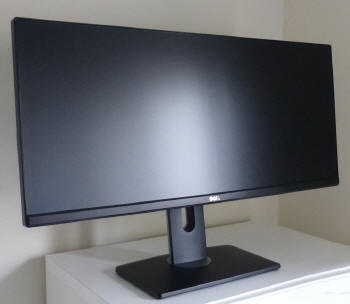
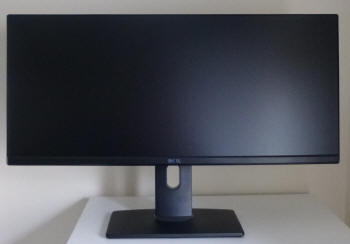
Above: front views of the screen. Click for larger version (bottom only)
The U2913WM looks like a horizontally stretched
version of the other recent Dell screens like the
U2713HM. It comes in an all-black coloured
design with matte plastics used for the bezel and stand. The lower bezel
features a shiny silver coloured Dell logo in the centre as you can see from
the above images. There is no other writing on the bezel at all.
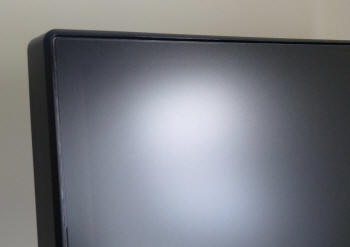
Above:
borderless design of top and side edges. Click for larger version
The bezel actually only protrudes along the
bottom edge and it measures ~20mm thickness. On the sides and top edge the
screen features a "borderless" design where the screen edge is flat to the
panel. It's like some of the other "edge to edge" and "frameless" displays
we've seen in recent months. Of course there is still an edge to where the
image reaches, measuring ~11mm thickness along the sides and top. With its
thin edges the screen looks pretty sleek although the aspect ratio and width
are quite unusual at first. You soon get used to it though after a few days of
use.
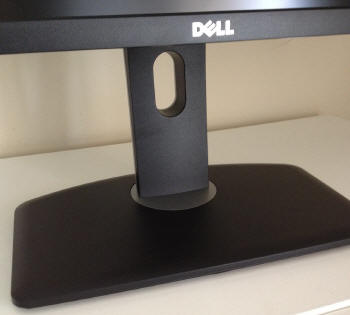
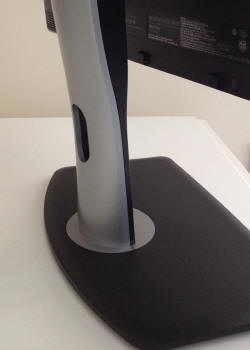
Above: views of the base and stand. Click for larger versions
The base of the stand is fairly large,
measuring 288mm width and is
made from a matte black plastic. It provides a decent balance for the
screen and it remains sturdy when positioned on the desk.


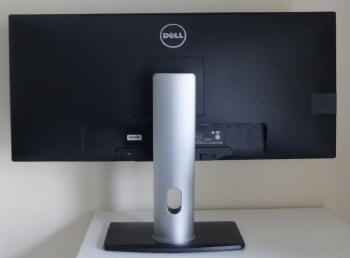
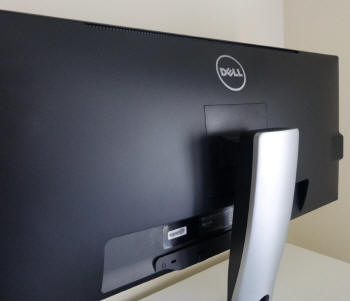
Above: views of the back of the screen. Click for larger versions
The back of the screen is again a matte black
plastic and is nicely rounded and enclosed well. There is a round matte silver Dell logo at
the top as shown above. The interface connections are located in the lower
portion which you can see from the above image. Since the screen does not
offer a rotate adjustment from the stand it can be a little tricky to connect
the cables in some cases, but that shouldn't be something you need to change
regularly anyway. While the front of the monitor
arm / stand is a matte black colour, the back of the stand is a silver
coloured plastic which looks nice and provides a good contrast to the black
plastics elsewhere. The same style as we've become used to with other recent
Dell screens.

The stand comes packages disconnected from the
screen in the box. It is incredibly easy to connection and you simply slot it
into the panel and it clips in to place. You are able to VESA 100mm wall-mount
the screen if you wish as well, and thanks to its very thin profile and relatively light
weight (5.76Kg without the stand) it is an interesting option to consider.
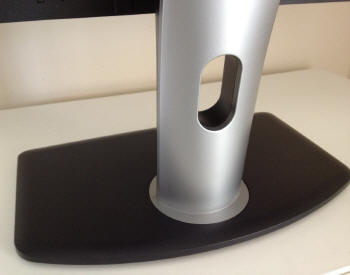
Above: view of the base and stand and cable tidy hole. Click for larger
version
There is a useful cable tidy hole as you can see
from the images above.

The screen is also provided with a small Velcro cable
tidy clip to help keep everything neat.

Above: views of the top of the screen
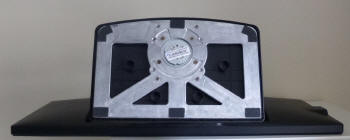
Above: bottom view of the screen. Click for larger version
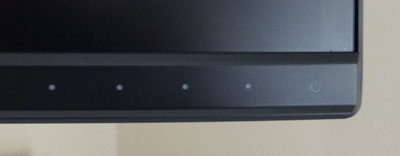
Above: OSD operational buttons and power button
The OSD operational buttons and power on/off are
located in the bottom right hand corner and are situated on the front of the
screen as shown, along the right hand side. All buttons including the power are touch sensitive. These only light
up when you use them and so are very well hidden during normal use. When the screen is turned on the power LED glows a subtle
white colour, and it pulsates on and off in the same white colour when the
screen is in
standby.

Above: side view of the screen showing profile
The screen has a fairly thin profile from
the side thanks to the use of a W-LED backlighting unit. It measures only
194.2 mm deep with the stand. Without the stand it is only 61.2mm.


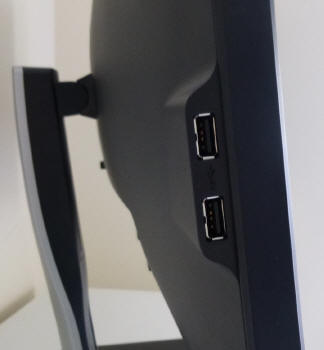
Above: Side view showing 2x USB 3.0 ports. Click for larger version
The screen offers 2x USB 3.0 ports on the
left hand edge of the screen as shown above, for easy access and
connection of peripherals. There are a further 2 ports on the back of the
screen too.


The U2913WM comes with the usual very good
range of ergonomic adjustments from the stand which is great news. The
only thing not featured here is a rotate adjustment, but with its very
large screen size and wide format that would be very impractical anyway.
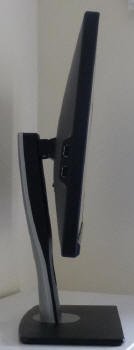
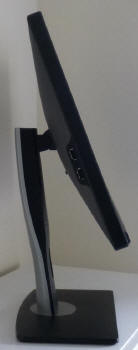
Above: side views showing full range of tilt adjustment. Click for larger
versions
There is wide tilt range, allowing you to
move the screen forward 4� and back by 21�. This affords you a good range
for a wide variety of angles. The movement is easy and smooth.
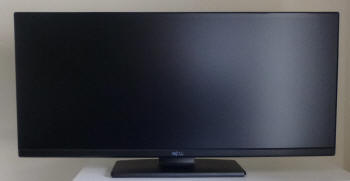
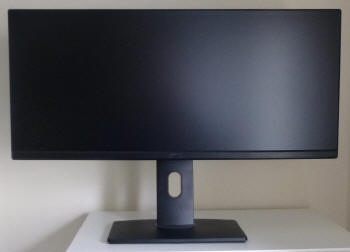
Above: front views showing full range of height adjustment. Click for
larger versions
The height adjustment range is also very good. At the
lowest setting the bottom of the lower bezel is approximately 35mm from the
desk so you can get a nice low height if you require. At its highest setting
the bottom of the bezel sits 165mm from the desk giving you a total adjustment
range of 130mm. The
movement is again easy and smooth, but a little stiffer than the tilt.
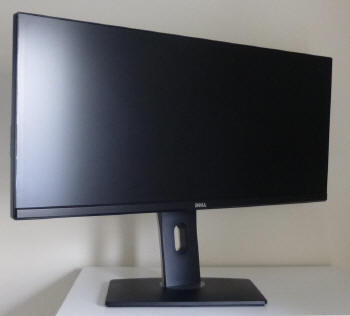
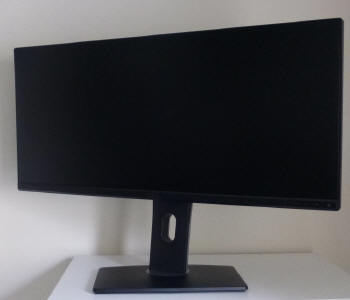
Above: Side to side swivel range of the screen. Click for larger versions
The
swivel adjustment is smooth and easy as well, and the screen stays firm on the
desk while the stand swivels from side to side. It's good to see the
wide range of adjustments available and all are
easy to use really, offering a decent range of adjustments and an overall
sturdy feel. There is no real wobble from the screen while it's sat on the
desk which is good.
A summary of the screens ergonomic adjustments
is shown below:
|
Function |
Range |
Smoothness |
Ease of Use |
|
Tilt |
-21�
to +4� |
Smooth |
Easy |
|
Height |
130mm |
Smooth |
A little stiff |
|
Swivel |
45�
+/- |
Smooth |
Easy |
|
Rotate |
n/a |
- |
- |
|
Overall |
Good range of adjustments and mostly easy to
use. Sturdy design and feel. |
The screen materials are of a good quality and
the design is attractive in my opinion. There is no audible noise from the
screen during use, even if you listen very closely. The screen also doesn't
seem to suffer from the buzzing issue of the U2713HM and U2713H when
displaying certain content with a lot of text. This was only a minor issue on
the other screens and very rare to reproduce in day to day uses, but it's good
to see the U2913WM does not appear to be affected anyway. The screen stays
nice and cool during use thanks to its W-LED backlighting unit.


Above: interface connections on back of the screen. Click for larger
version
The back of the screen features video input
connections for D-sub, DisplayPort, Mini DisplayPort, DL-DVI and, HDMI. The
digital connections are HDCP certified. To the right of the HDMI is the
DisplayPort out connection, allowing you to daisy chain several screens if you
want. There is also a standard kettle lead power connection as the screen has
an integrated power supply. This does make it a little thicker than some of
the ultra-thin profile screens you can find which offer an external power
brick. There is a single connection for Dell's sound bar if you want to add
some speakers to the screen and there's an audio-out socket if you'd rather
connect headphones or an external speaker system to listen to the sound from
the HDMI and DisplayPort connections. There is also 1x USB upstream for
connecting to your PC (cable provided) and 2x USB 3.0 downstream ports
available for connecting external devices. Note these are the new generation
USB 3.0 ports providing faster transfer rates for compatible devices.

Above:
Comparison of the U2913WM, U2713H and U2413 screens side by side. Click for larger
version
For interest, we've provided a side by side
picture of the U2913WM, U2713H and U2413 screens to give you an idea of the
size variations.
Note: some of the above images courtesy of
Dell

OSD Menu


Above: OSD operational buttons and power button
Like the new Dell U2713H the U2913WM has
touch-sensitive
OSD buttons. These 4 buttons are located on
the right hand side of the screen next to the power button (also touch sensitive
here). The
sensitivity works well in practice. Pressing any of the buttons brings up the 4
options available from the 4 touch sensitive buttons as shown below. All the
buttons light up in a white colour to show they are now available to use. The
power LED glows white by the way during normal use, and pulses on / off white
when the screen is in standby. At first these buttons all make a loud beep noise
when being used but thankfully that can be turned off within the OSD menu as
it's pretty annoying.
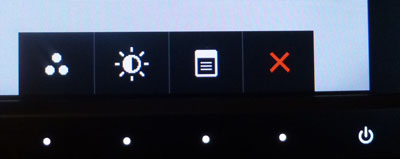
From here there is quick access to preset mode
selection, brightness / contrast controls and access to the main menu itself. You can in fact
personalise the three quick launch options from within the main menu should you
wish to.
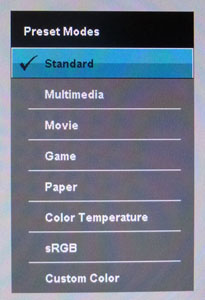
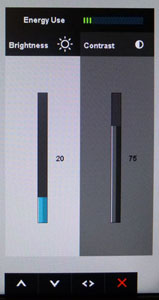
Within the preset modes menu there are options for
standard, multimedia, movie, game, paper, colour temperature, sRGB and custom colour.
The paper preset is new and replaces the 'text' mode which used to feature
instead on Dell UltraSharp monitors. The sRGB mode here carries the factory calibration which we will
test later on.
If you enter the 'custom color' mode you have access to adjustments for the RGB
channels. The second button gives you access to the brightness and contrast
controls as shown above as well.
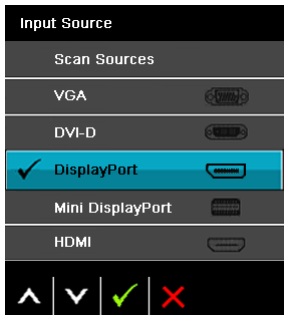
If the screen is in standby or detects no input
signal, pressing the OSD buttons brings up quick access to the input selection
as shown above.
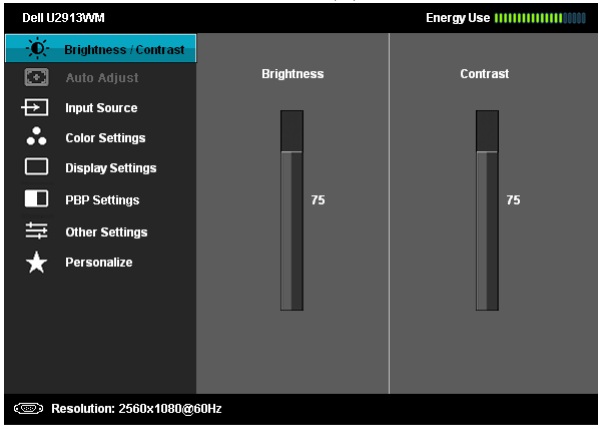
Bringing up the main menu presents you with
various sub-sections down the left hand side as shown. At the top right there is the now familiar "energy
use" bar which gives you a visual indication of the power consumption at any
given time. This is based on the OSD brightness setting which controls the
backlight intensity, and therefore has a direct correlation to the power
consumption. The brightness/contrast section is self explanatory of course and
is shown above. The 'auto adjust' section is only applicable when using the
analogue VGA (D-sub) input.
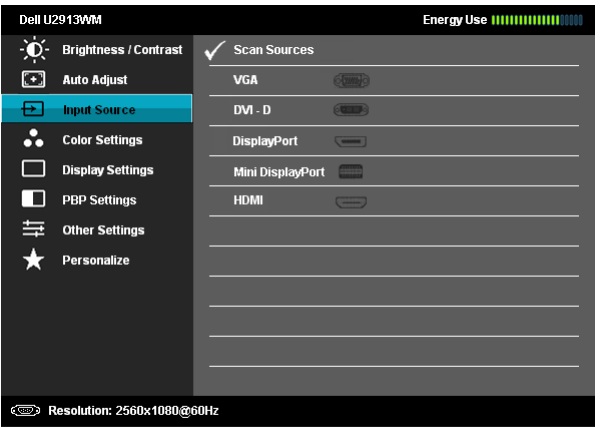
The input source section allows you to manually
select which interface is in use.
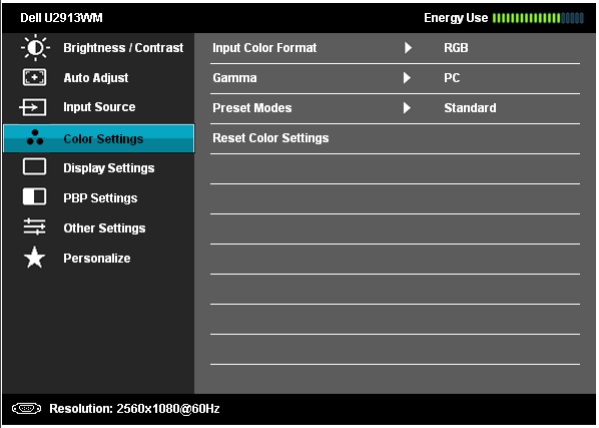
Colour settings allows you to change a couple of
settings relating to colour format and gamma, but perhaps more useful here is
access to the preset colour modes.
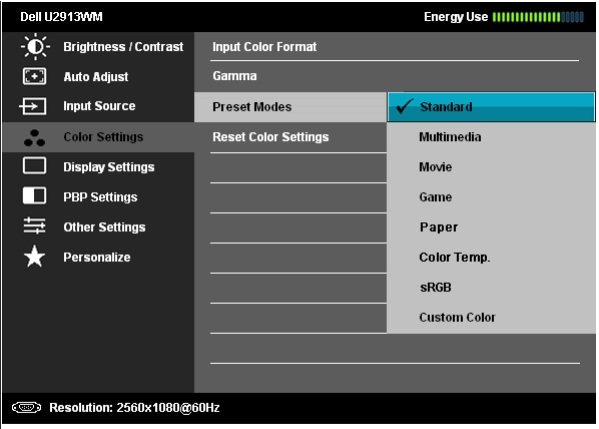
The preset modes listed here are the same as those
accessed via the quick launch menu.
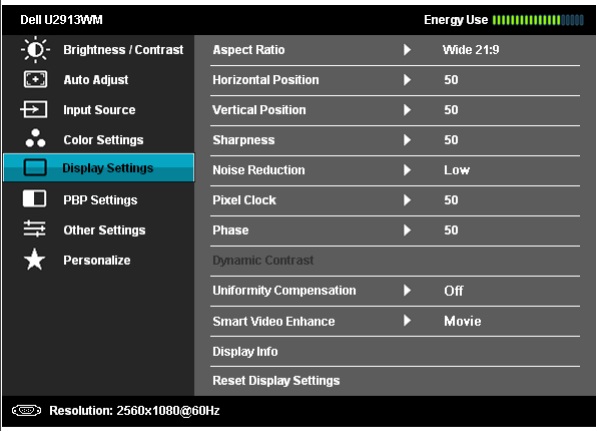
The display settings section allows you to change
the monitors aspect ratio for external devices and games. There are options for
wide 21:9, wide 16:9, auto resize and 1:1 here. You can also turn the
dynamic contrast ratio
control on and off in this section of the menu, if you are in a suitable preset
mode where it can be activated. Of other note is the new 'Uniformity
Compensation' option which we will
test later on
as well.
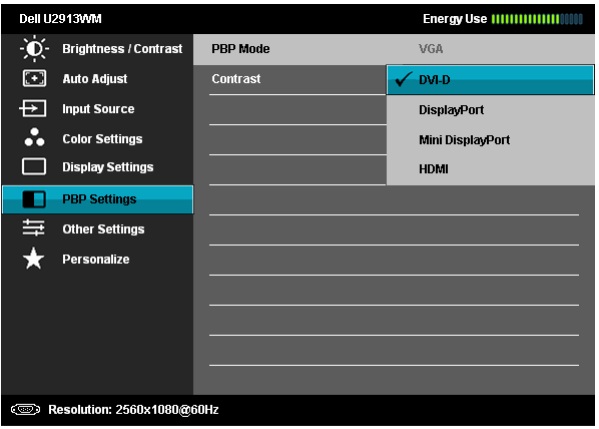
The PbP settings section allows you to control
various options related to Picture By Picture
(PbP). The following configurations are available according to the manual.
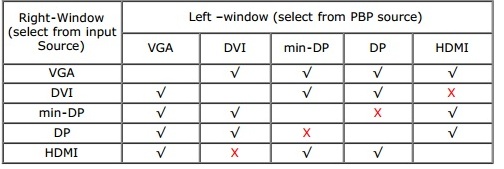
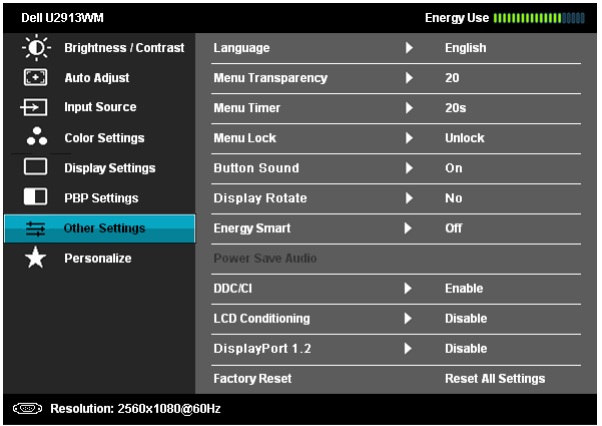
The other settings section has some controls over
the OSD itself. The 'Energy Smart' feature can be turned on and off here as
well.
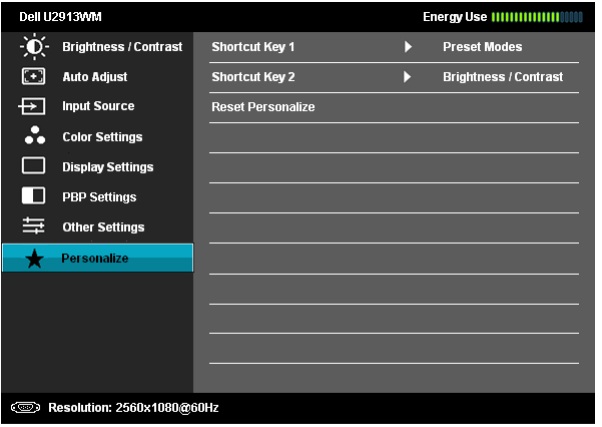
The personalize section allows you to change the
quick launch keys if you wish.
Overall the OSD menu offers a decent range of
options and it is intuitive and well structured. The touch sensitive buttons
worked well on the most part although we did find it a little tricky to click
and hold a button sometimes (e.g. when scrolling rapidly between brightness
settings). Sometimes they didn't respond as hoped but on the whole they were
useable.

Power Consumption

In terms of power consumption the manufacturers spec states
typical
usage of 32W and 90W maximum (with luminance max, USB connected and SoundBar
connected). In standby the screen apparently uses <0.5W.
|
 |
|
State and Brightness
Setting |
Manufacturer Spec (W) |
Measured Power Usage
(W) |
|
Factory Default (75%) |
32.0 |
34.0 |
|
Calibrated (33%) |
- |
23.6 |
|
Maximum Brightness (100%) |
90.0 |
42.1 |
|
Minimum Brightness (0%) |
- |
19.3 |
|
Standby |
<0.5 |
0.8 |
|
We tested this ourselves and found that out of the
box the screen used 34W of power while at its default brightness setting. At
the maximum brightness level the screen used 42.1W of
power (this was without USB / SoundBar connected), and at the lowest setting this was measured at 19.3W. Once calibrated we
had reached a power consumption of 23.6W which had been once the screen had been
set to achieve a luminance of 120
cd/m2. During
standby the screen uses 0.8W of power.
We have plotted the results of these measurements
on the graph below:


Panel and Backlighting
|
Panel Manufacturer |
LG.Display |
Colour Palette |
16.7 million |
|
Panel Technology |
AH-IPS |
Colour Depth |
8-bit |
|
Panel Module |
LM290WW1-SSA1 |
Colour space |
Standard Gamut |
|
Backlighting Type |
W-LED |
Colour space coverage (%) |
~72% NTSC, >99% sRGB |
Panel and Colour Depth
The Dell U2913WM utilises an
LG.Display LM290WW1-SSA1 AH-IPS panel which is capable of producing 16.7
million colours with an 8-bit colour depth. Dell refer to the panel as being
"AH-IPS" (Advanced High Performance IPS) in some of their marketing material,
and it is a name which is starting to become more common in today's IPS market.
We have started to see other screens emerge with these so-called AH-IPS panels
in their specs, and indeed LG.Display themselves made the same distinction when
discussing their forthcoming panels
earlier in the year, although this new 29" panel wasn't specifically
mentioned in the road-map.
The panel is confirmed when dismantling the screen
as shown below.
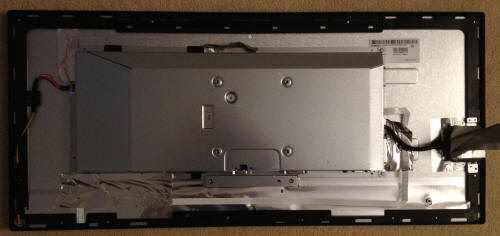

Above: view of
the panel used and dismantled screen.
Panel Coating
The
screen coating on the U2913WM is much like that featured on the recent U2713HM
/ U2713H models which
has been a positive change. It is a normal anti-glare (AG) offering
as opposed to any kind of glossy coating. However, this is contrary to a lot of
other older IPS based screens which usually feature a grainy and aggressive
solution. Dell seem to have toned down the
AG coating on recent models including the U2913WM which is great news. It retains its anti-glare
properties to avoid unwanted reflections, but does not produce an overly grainy
or dirty image that some AG coatings can. This is a light AG coating type.
As a side note, some users reported a "cross
hatching" appearance on the recent U2713HM screen, where on very close
inspection you could detect a small grid like effect as part of the coating.
This didn't affect everyone of course but it was something some people
complained about or became sensitive to. Having seen this so-called cross
hatching on the U2713HM we're pleased to report that the U2913WM is free from
this and does not show any sign of it, even when looking very closely for it.
Backlighting and Colour Gamut
The U2913WM uses
White-LED (W-LED) backlighting. The colour space of this screen is
approximately equal to the sRGB reference and is considered a 'standard gamut'
backlight type. The screen covers 72% of the NTSC reference and >99% of the sRGB
space according to Dell's specs. A wide gamut screen would need to be considered
by those wanting to work outside of the sRGB colour space of course.
PWM Flicker Tests at Various
Backlight Brightness Settings
100% 50%
0%

|
Pulse Width
Modulation Used |
No |
|
Cycling
Frequency |
n/a |
|
Possible
Flicker at |
|
|
Maximum Brightness |
No |
|
Middle Brightness |
No |
|
Minimum Brightness |
No |
We tested the screen to establish the methods used
to control backlight dimming. Our recent article talks in more details about a
common method used for this which is called
Pulse Width Modulation (PWM). A series of photos was taken using the method
outlined in the article. These were taken at maximum 100%, medium 50% and minimum
0% brightness
settings. These tests
allow us to establish 1) whether PWM is being used to control the backlight, 2)
the approximate frequency at which this operates, and 3) whether a flicker may be introduced
or potentially noticeable at certain settings.
A thin white line was shown on an all-black
background and a photograph was taken at a slow shutter speed of 1/8 second (in
this example) as
the camera was scanned left to right in front of the screen. This produces a
series of white lines which can be used to identify the frequency of the PWM and
how quickly the backlight is cycled on and off. The higher this frequency, the
less likely you are to see artefacts and flicker. The duty cycle (the time for
which the backlight is on) is also important and the shorter the duty cycle, the
more potential there is that you may see flicker. Please remember that not every
user would notice a flicker from the backlight but it is something to be wary
of. It is also a hard thing to quantify as it is very subjective when talking
about whether a user may or may not experience the side effects. We are able to
at least measure the frequency of the backlight using this method and tell you
whether the duty cycle is sufficiently short at certain settings that it may
introduce a flicker to those sensitive to it.
We can confirm that the U2913WM does not use PWM at
all for dimming of the backlight, which is the same as the recent U2713HM and
U2713H in fact. Even at 0% brightness there was no sign of the usual splitting
of the white line that you'd expect to see in these tests. We carried out the
checks at an even slower shutter speed which returned the same result. This is
great news for those who are affected by flickering backlights and suffer from
eye fatigue and eye strain. It seems we have seen quite a few new monitors
recently which don't use PWM for backlight dimming which is very welcome.

Testing
Methodology
An
important thing to consider for most users is how a screen will perform out of
the box and with some basic manual adjustments. Since most users won't have
access to hardware colorimeter tools, it is important to understand how the
screen is going to perform in terms of colour accuracy for the average user.
I
restored my graphics card to default settings and disabled any previously active
ICC profiles and gamma corrections. The screen was tested at default factory settings using the DVI interface, and analysed using
an
X-rite i1
Pro Spectrophotometer (not to be confused with the new i1 Display Pro
colorimeter) combined with
LaCie's Blue Eye Pro software suite. An NEC branded and customised X-rite i1 Display 2 colorimeter was
also used to verify the black point and contrast ratio since the i1 Pro is less
reliable at the darker end.
Targets for these tests are as follows:
-
CIE Diagram - validates the colour space
covered by the monitors backlighting in a 2D view, with the black triangle representing the
displays gamut, and other reference colour spaces shown for comparison
-
Gamma - we aim for 2.2 which is the default
for computer monitors
-
Colour temperature / white point - we aim
for 6500k which is the temperature of daylight
-
Luminance - we aim for 120
cd/m2, which is
the recommended luminance for LCD monitors in normal lighting conditions
-
Black depth - we aim
for as low as possible to maximise shadow detail and to offer us the best
contrast ratio
-
Contrast ratio - we aim
for as high as possible. Any dynamic contrast ratio controls are turned off here
if present
-
dE average / maximum -
as low as possible.
If DeltaE >3, the color displayed is significantly different from the
theoretical one, meaning that the difference will be perceptible to the
viewer.
If DeltaE <2, LaCie considers the calibration a success; there remains a
slight difference, but it is barely undetectable.
If DeltaE < 1, the color fidelity is excellent.

Default Performance and
Setup
Default settings of the screen were as follows:
|
Monitor OSD Option |
Default Settings |
|
Brightness |
75% |
|
Contrast |
75% |
|
Preset Mode |
Standard |
|
RGB |
n/a |

Dell U2913WM - Default Factory Settings, Standard Mode


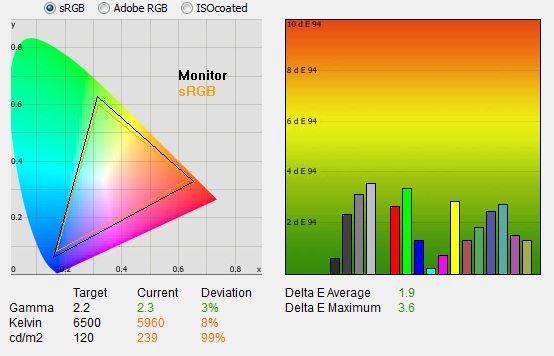
|
|
Default Settings
Standard Mode |
|
luminance (cd/m2) |
239 |
|
Black Point (cd/m2) |
0.21 |
|
Contrast Ratio |
1123:1 |
The screen comes out of the box in the 'standard'
preset mode, although there is an additional sRGB preset mode which carries a
factory calibration
which we will test shortly. Default setup of the screen felt too bright which is
pretty standard for modern screens but can be easily controlled of course via
the brightness control. Apart from that the colours felt well balanced on the
whole and you could tell that the colour space was a standard sRGB. We could
notice the difference easily when coming from a wide gamut screen like the
U2713H we'd just finished testing.
Out of the box the performance of the screen was
pretty good in this standard mode. The
CIE diagram on the left of the image confirms that the monitors colour gamut
(black triangle) matches the sRGB colour space (orange triangle) pretty closely,
extending a little beyond the sRGB reference in some shades (greens mainly) and
falling slightly short in some others (reds).

Default gamma was recorded at 2.3 average, leaving
it only a small 3% out from the target of 2.2 which was good overall. However
the gamma curve was a little off as it was too low in dark shades and too
high in light shades as you can see from the table above. White point was
a little off the target as well, being a little too warm and recorded at 5960k
(8% out). Note that we are using a
spectrophotometer to make these measurements which is not sensitive to the LED
backlight as some colorimeter devices can be. When using a standard gamut colorimeter
not designed to work with modern backlighting units like W-LED, WCG-CCFL and
GB-LED there can be a typical deviance of 300 - 600k in the white
point measurement which is why some sources may refer to a different white point
in this test incorrectly.
Luminance was recorded at a high, but not too
bright 239
cd/m2 which is
still too high for prolonged general use. The screen was set at a default 75%
brightness in the OSD menu but that is easy to change of course to reach a more
comfortable setting. The black depth was a very good 0.21 cd/m2, giving us an
excellent static contrast ratio for an IPS panel of
1123:1.
Colour accuracy was also very good out of the box
which was great news, even in this standard preset mode which doesn't carry a
specific
factory calibration as such. DeltaE was recorded at 1.9 average, with maximum of
3.6 and so overall colour accuracy was very good. Testing the screen with various gradients showed smooth transitions with no sign
of any banding thankfully. There was some noticeable gradation, particularly in darker tones as
you will see from most monitors. Perhaps a little more obvious though than some
other screens we've tested.

|
Monitor OSD Option |
Default Settings |
|
Brightness |
75 |
|
Contrast |
75 |
|
Preset mode |
Custom Color |
|
RGB |
100, 100, 100 |

Dell U2913WM - Default Settings, Custom Color Mode
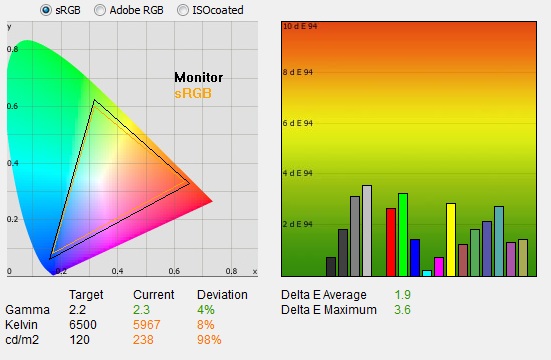
|
|
Default Settings, Custom
Color mode |
|
luminance (cd/m2) |
238 |
|
Black Point (cd/m2) |
0.21 |
|
Contrast Ratio |
1124:1 |
We also tested the default performance in the
'custom color' preset. This mode allows you access to the individual RGB
channels which will give you more control over the hardware when it comes to
calibration. The performance in this mode was pretty much identical to the
standard preset mode as you can see from the report above. No real difference at
all here, but this mode would provide more flexibility with adjustments to the
hardware when it comes to
calibration.


Factory
Calibration

Like some of the other recent Dell UltraSharp
screens the U2913WM comes
factory calibrated to some extent, and the box even includes a calibration
report from Dell specific to the unit you have. It states that every unit is
shipped incorporating pre-tuned sRGB mode which offers an average DeltaE of <5.
In
addition to this, they have tweaked gamma and grey-scale to help to ensure
smooth gradients and an accurate initial setup. As a new extra they have also
apparently adjusted luminance and colour uniformity across the screen to meet dE
<5 and uniformity of 97 - 102%, which is available
from within the OSD as an option we will
test later on. I've included a copy of the
calibration report from the Dell factory below for you to review. Note that this
report is only relevant to our specific test unit and they do state that results
may vary with each setup and different test equipment.

I was
interested to see if this factory calibration helped at all with default
settings. Note that this is only relevant for the sRGB preset mode available
through the OSD menu. You will need to change from the default 'Standard'
profile to benefit from these factory calibrated settings.

Dell U2913WM - Default Factory Calibration, sRGB mode
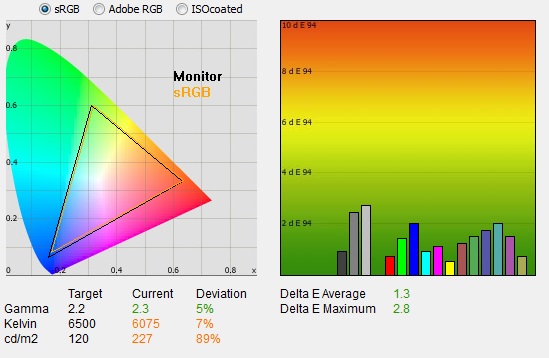
|
|
Default Factory Calibration,
sRGB mode |
|
luminance (cd/m2) |
227 |
|
Black Point (cd/m2) |
0.21 |
|
Contrast Ratio |
1094:1 |
The factory calibration of the sRGB preset mode
was also very pleasing on the most part. This mode actually offered a slight
reduction in the monitors native gamut to provide an even more reliable
emulation of the sRGB colour space. This might be useful for colour critical
work in the sRGB colour space and for those who need to more precisely match
this reference. A comparison of the gamut in the sRGB mode compared with the
native gamut of the screen (from the standard mode) is shown below:
Comparison of monitor colour space coverage
in standard mode (left) vs. sRGB mode (right)
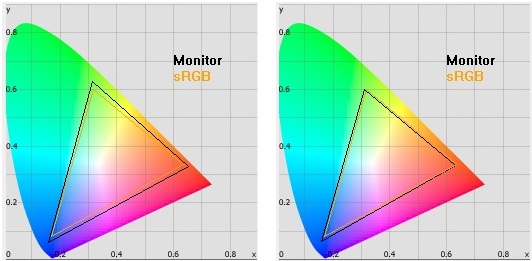

The gamma was still a little out from the target
of 2.2, being measured at 2.3 average (5% deviance) and with some variation
across the range of grey shades. The white point was measured at 6075k leaving
it 7% out from our target. To be fair though, if you look at the factory
calibration report you will see the screen has been deliberately set up to
~6000k white point and so this factory calibration is actually very reliable. We
aim for a target of 6500k in our tests which is why it shows as being a little
out.
Luminance was still too high, but easy enough to
adjust through the OSD menu and not something Dell have bothered to adjust out
of the box as it's very easy for the user to change to their taste, without any
significant impact on other areas. The contrast ratio was excellent still, and
very similar to before at 1094:1. The colour accuracy was a little better than
the other preset modes with dE 1.3 average and maximum of only 2.8. Overall the factory
calibration was very good although the gamma curve was a little off.

Testing Colour Temperatures
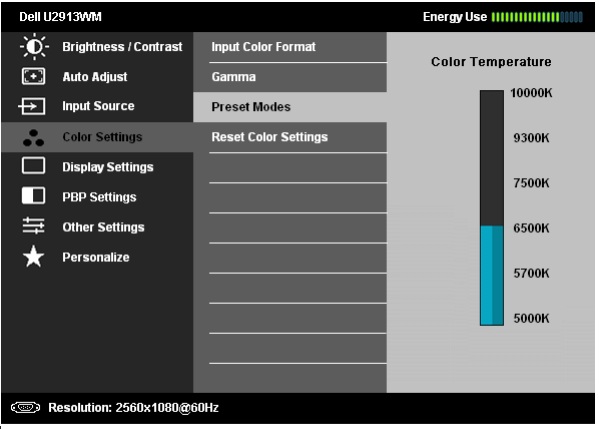
The U2913WM features a range of colour
temperature
presets within the OSD 'color settings' menu as shown above. You have to choose
the specific 'color temp' preset mode first but you are then asked to define
your target colour temp from the 6 presets available. We measured the screen
with the X-rite i1 Pro spectrophotometer in each of the preset modes to establish
their colour temperature / white point. All other settings were left at factory defaults and no
ICC profile was active. The results are recorded below:
|
Selected Preset Mode (k) |
Measured Colour Temperature (k) |
Deviance from target (k) |
Deviance % |
|
10,000 |
10230 |
230 |
2.3% |
|
9300 |
9339 |
39 |
0.4% |
|
7500 |
7450 |
-50 |
-0.7% |
|
6500 |
5998 |
-502 |
-7.7% |
|
5700 |
5782 |
82 |
1.4% |
|
5000 |
5055 |
55 |
1.1% |
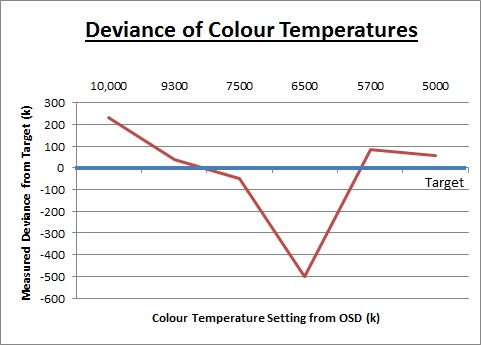
The colour temperature modes offered reasonable
levels of accuracy overall with a maximum deviance from the target of only
7.7%. The coolest setting of 10,000k was a little off, being 230k too cool
(2.3% deviance). The 9300, 7500, 5700 and 5000k modes were all very close to
their desired white points with <100k deviance in each case which was great.
The setting with the most deviance however was the 6500k mode which sadly is
the one many users may wish to use day to day. This seemed to be set up at
closer to 6000k for some reason (5988k measured) and so showed the largest
deviance of 7.7%. Overall the
preset colour temp modes were reasonable really although not as accurate as
you might see on some other high end pro grade screens from the likes of
Samsung, NEC and Eizo.

Calibration Results
The U2913WM may well have a decent
default and
factory setup but some users may still want to calibrate the screen personally to obtain even
higher levels of accuracy and allow profiling and matching between different
devices. Remember, you need to ensure you have a device capable of measuring
and reading the spectra from the W-LED backlight unit properly. Many older
colorimeter devices are designed to work with standard gamut CCFL units only and
so they can often have difficulty reading LED (and wide gamut CCFL) units
properly. A spectrophotometer does not have this problem and there are also some
decent modern colorimeters like the X-rite i1 Display Pro which should be able
to read LED without issue. While you can use other devices and various software
packages to complete software profiling of the screen, you may come across
issues if the device is not designed to work with an LED backlight unit.
We used the
X-rite i1 Pro spectrophotometer combined with the LaCie Blue Eye Pro
software package to achieve these results and reports. An NEC branded and
customised X-rite i1 Display 2 was used to validate the black depth and contrast
ratios due to lower end limitations of the i1 Pro device.
|
Monitor OSD Option |
Calibrated Settings |
|
Brightness |
33 |
|
Contrast |
75 |
|
Preset mode |
Custom Color |
|
RGB (Gain) |
96, 98, 100 |

Dell U2913WM - Calibrated Settings, Custom Color Mode
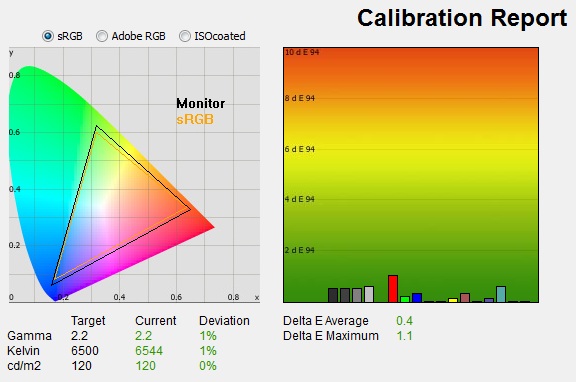
|
|
Calibrated Settings, Custom Color mode |
|
luminance (cd/m2) |
120 |
|
Black Point (cd/m2) |
0.12 |
|
Contrast Ratio |
1011:1 |
I first of all reverted to the 'custom color' mode in the
preset section of the OSD menu which would allow me access to the individual RGB channels.
Adjustments were made during the process to the brightness control, and to
the RGB channels as shown in the table above. This allowed me to obtain an
optimum hardware starting point and setup before software level changes would be
made at the graphics card level which would help preserve tonal values. After this I let the software carry out the LUT adjustments and create an
ICC profile.

Average gamma had been corrected to 2.2 with a
small 1%
deviance according to the initial test, correcting the large default 4% deviance we'd
found in this preset. Checking the more detailed table shown
above, the gamma curve was now improved across the range of grey shades which
was good news. The 8% deviance in the white point from our target
of 6500k had also been corrected here and the colour temperature was now pretty
much spot on at 6544k (1% out). Luminance had also been corrected thanks to the adjustment to the
brightness control, now being measured at 120
cd/m2 spot on.
This also gave us a calibrated black depth of 0.12 cd/m2, and a
static contrast ratio of 1011:1 which was excellent for an IPS panel. Colour
accuracy had also been corrected nicely, with dE average of 0.4 and maximum of
1.1. LaCie would consider colour fidelity to be excellent.
Testing the screen with various colour gradients
showed reasonably smooth transitions. There was some gradation in darker tones
and some slight banding introduced due to the adjustments to the graphics
card LUT from the profilation of the screen. Nothing too major at all though. It's
worth also commenting on the screen coating in this section of the review.
Unlike many other IPS panels, this screen does not feature the usual heavy and
aggressive Anti-glare (AG) coating which can sometimes lead to grainy and dirty
looking images. Instead it uses a light AG screen coating
and as a result the colours look more clean and crisp, the image quality is
sharp and whites in particular look more pure than they do on heavy AG coated
screens. It isn't a full glossy solution which adds another level of clarity and
changes the overall feel of the screen, but it is an improvement over the heavy
AG coating of some other IPS screens, including some of Dell's old models like
the U2410 and U2711 (but improved on modern screens like the U2713HM and U2713H). A
positive change and hopefully something we will start to see more of with future
IPS screens.
You can use our settings and
try our calibrated ICC profile if you wish, which are available in
our ICC profile database. Keep in mind that results will vary from one
screen to another and from one computer / graphics card to another.

Dell U2913WM - Calibrated Settings, sRGB Mode
|
Monitor OSD Option |
Calibrated Settings |
|
Brightness |
36 |
|
Contrast |
75 |
|
RGB Channels |
n/a |
|
Preset Mode |
sRGB |
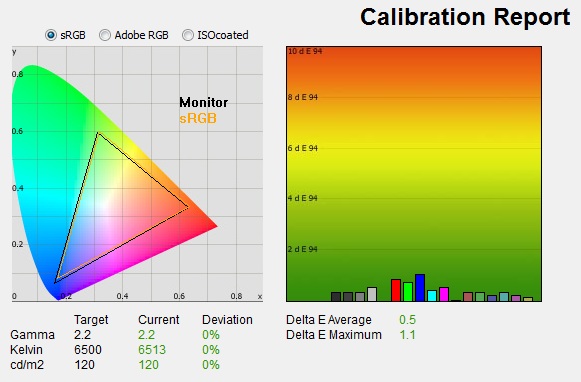
|
|
Calibrated Settings,
sRGB mode |
|
luminance (cd/m2) |
120 |
|
Black Point (cd/m2) |
0.12 |
|
Contrast Ratio |
1012:1 |
I also carried out the calibration in the monitors
'sRGB' mode where the colour space was more tightly matched compared with the
backlights native gamut. Here you do not have access to the RGB channels at all,
and so the only hardware changes being made are to the brightness control. The
other corrections would be carried out at a graphics card LUT level through the
profiling process. The results were again very pleasing. Targets for gamma and
white point had all been met nicely, correcting the 5% and 7% deviations
respectively we had seen out of the box in this mode. The luminance had been
corrected to the desired level with the change in the brightness control, and
the static contrast ratio was still an excellent 1012:1 after calibration. Colour
accuracy had been improved from the already very good dE 1.3 average we had seen out of the box
thanks to the factory calibration, now down to 0.5 dE average. Testing the screen with various colour gradients showed
mostly smooth transitions
on the whole, with some gradation and some very slight banding in some
darker
shades due to the graphics card corrections made.
You can use our settings and
try our calibrated ICC profile if you wish, which are available in
our ICC profile database.

Calibration
Performance Comparisons

The comparisons made in this section try to give
you a better view of how each screen performs, particularly out of the box which
is what is going to matter to most consumers. When comparing the default factory
settings for each monitor it is important to take into account several
measurement areas - gamma, white point and colour accuracy. There's no point
having a low dE colour accuracy figure if the gamma curve is way off for
instance. A good factory calibration requires all 3 to be well set up. We have
deliberately not included luminance in this comparison since this is normally
far too high by default on every screen. However, that is very easily controlled
through the brightness setting (on most screens) and should not impact the other
areas being measured anyway. It is easy enough to obtain a suitable luminance
for your working conditions and individual preferences, but a reliable factory
setup in gamma, white point and colour accuracy is important and not as easy to
change accurately without a calibration tool.
From these comparisons we can also compare the
calibrated colour accuracy, black depth and contrast ratio. After a calibration
the gamma, white point and luminance should all be at their desired targets.
Default setup of the U2913WM in the non-factory
calibrated "standard" mode was pretty good really. There was a small
3% deviance in the gamma, being measured at 2.3 average. The white point
was a little further adrift, being measured at 5960k and with an 8% deviance
from our target. To be fair the screen seems to have been deliberately set up
for a 6000k white point so this isn't "inaccurate" as such, but is not as near
to our desired white point as we'd like. Default colour accuracy was very good
with a very low 1.9 dE average out of the box.

Default colour accuracy is compared again on the
above graph, with the U2913WM having a very reliable default setup which is
pleasing.

Once calibrated the dE average was reduced to 0.4.
This would be classified as excellent colour fidelity by LaCie. It was not quite
as low as some of the other screens here which reached down to 0.2 average, but
in practice you would not notice any difference here at all. The professional
range models from NEC and Eizo are even more accurate than other models shown
here. Professional grade monitors like those offer other high end features which
separate them from some of these other models, including extended internal
processing, 3D LUT's and hardware calibration. These comparisons are based on a
small selection of tests, so it should be remembered that other factors do come
into play when you start talking about professional use.

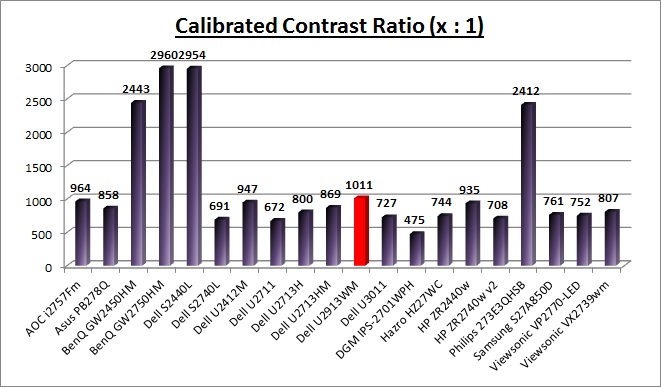
The calibrated black depth and contrast ratio of
the U2913WM were excellent for an IPS panel. At 1011:1, the contrast
ratio was the highest we'd seen after calibration from an IPS panel, even
outdoing some other strong contenders from Dell like the
U2412M (947:1) and the
U2713HM (869:1). This was a great result and we were impressed. Those needing an
even higher CR may want to consider other technologies like AMVA as at the
moment the U2913WM is about as good as you can hope for from a modern IPS panel.

Contrast
Stability
I wanted to see how much variance there was in the screens contrast as we
adjusted the monitor setting for brightness.
In theory, brightness and contrast are two independent parameters, and good
contrast is a requirement regardless of the brightness adjustment.
Unfortunately, such is not always the case in practice. We recorded the
screens luminance and black depth at various OSD brightness settings, and
calculated the contrast ratio from there. Graphics card settings were left at
default with no ICC profile or calibration active. Tests were made using an
NEC branded and customised
X-rite i1 Display 2 colorimeter. It should be noted that we used the
BasICColor calibration software here to record these, and so luminance at
default settings may vary a little from the LaCie Blue Eye Pro report.
|
OSD Brightness |
Luminance
(cd/m2) |
Black Point (cd/m2) |
Contrast Ratio
( x:1) |
|
100 |
312.95 |
0.28 |
1118 |
|
90 |
281.00 |
0.25 |
1124 |
|
80 |
250.37 |
0.22 |
1138 |
|
70 |
222.12 |
0.20 |
1111 |
|
60 |
199.68 |
0.18 |
1109 |
|
50 |
175.25 |
0.16 |
1095 |
|
40 |
150.46 |
0.13 |
1157 |
|
30 |
126.89 |
0.11 |
1154 |
|
20 |
101.50 |
0.09 |
1128 |
|
10 |
75.26 |
0.07 |
1075 |
|
0 |
50.39 |
0.05 |
1008 |
|
Total Luminance Adjustment Range
(cd/m2) |
262.56 |
Brightness OSD setting controls backlight? |
 |
|
Total Black Point
Adjustment Range (cd/m2) |
0.23 |
|
Average Static Contrast Ratio |
1111:1 |
PWM Free? |
 |
|
Recommended OSD setting for 120 cd/m2 |
27% |
The luminance range of the screen was excellent.
At the top end the panel reached a high 312.95
cd/m2 which was actually a little
higher than the specified maximum luminance of 300 cd/m2. This should
still be more than most users
would ever need as
an upper limit of course. At the lower adjustment end it could
reach down to a very low 50.39 cd/m2 which was good news and meant the screen should be
perfectly fine even in darkened room conditions, and for those who like to run
at a lower luminance setting. A brightness setting of ~27% should return you a
default luminance of around 120 cd/m2 as well out of the box. Black
point ranged from 0.28 cd/m2 down to
0.05 cd/m2 with the backlight adjustments.

We have plotted the
luminance trend on the graph above. The screen behaves as it should, with a
reduction in the backlight intensity controlled by the reduction in the OSD
brightness setting. This was pretty much a linear relationship and
is all achieved without the use of
Pulse Width Modulation
(PWM) as well which is
positive news.

Average contrast ratio
in the standard default preset mode was measured was 1111:1 which was excellent
for an IPS panel. It was pretty stable across the adjustment range with a small
drop at the lower end of the brightness scale below about 25%.

Dynamic Contrast
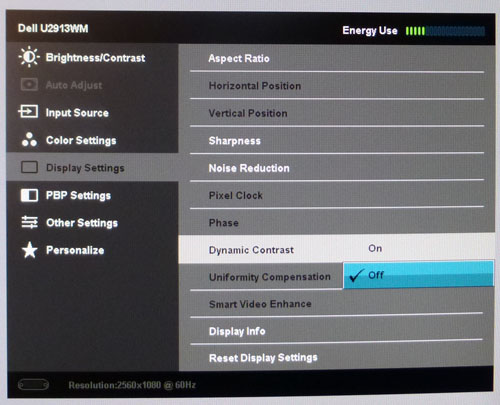
The Dell U2913WM features a dynamic contrast ratio
(DCR) control, which boasts a spec of 2,000,000:1 (2 million:1). Dynamic
contrast ratio involves controlling the backlight of the screen automatically,
depending on the content shown on the screen. In bright images, the backlight
is increased, and in darker images, it is decreased. We have come to learn
that DCR figures are greatly exaggerated and what is useable in reality is
often very different to what is written on paper or on a manufacturers
website.
For this test I would use the colorimeter to record the
luminance and black depths at the two extremes. Max brightness would be
recorded on an almost all white screen. Black depth would
be recorded on an almost all black screen. In real use you are very
unlikely to ever see a full black or full white screen, and even our tests are
an extreme case to be honest. Carrying out the tests in this way does give you
a good indication of the screens dynamic contrast ratio in real life
situations however.
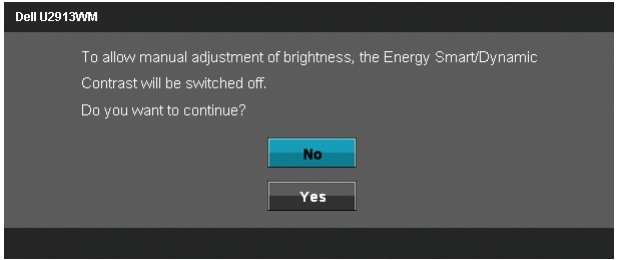
The DCR feature is available in only the movie
and game preset modes, and for some reason not in the multimedia preset. It
has a simple setting for on or off available from within the 'display
settings' section of the menu, and once enabled you cannot control the
brightness setting manually. If you do try to change it you are given the
above warning and the option to turn the DCR feature off.
|
|
Dynamic Contrast |
|
Specified DCR Range |
2 million: 1 |
|
Available in Presets |
Movie, Game |
|
Setting Identification / Menu option |
Dynamic Contrast |
|
Settings |
On / Off |
|
Measured
Results |
Movie mode |
Game mode |
|
Default Static Contrast Ratio |
710:1 |
1061:1 |
|
Max luminance DCR (cd/m2) |
203.27 |
304.96 |
|
Min Black Point DCR (cd/m2) |
0.11 |
0.11 |
|
Max Dynamic Contrast Ratio (DCR) |
1848:1 |
2772:1 |
|
Useable DCR in practice |
Yes |
Yes |
|
Backlight turned off for 100% black |
Yes |
Yes |
We tested the DCR feature in both the movie and
game preset modes. On these Dell screens you can observe the changes being made
in the OSD by looking at the energy meter in the top right hand corner as well
which is useful. When switching to an almost all-white screen you could see the
brightness change and the energy bar moved up to 1 bar away from the top
setting. The screen took about 1.5 seconds to change up each step in the energy
bar until it reached this maximum point. If we then switch to an almost
all-black screen the changes are far more subtle. At first there is no change to
the brightness but after ~20 seconds the energy bar drops down a step. This
continues every 20 seconds or so until the energy meter is only full up by 5 bars.
So the transitions of the backlight when moving to bright content are pretty
fast, but when moving to dark content they are very slow.
In the game preset mode we had measured a static
contrast ratio of 1061:1 which is pretty much what we'd seen in the standard and
custom preset modes before. With the DCR feature turned on, the backlight is
controlled up to 304.96
cd/m2 and down to a black depth of 0.11 cd/m2.
This gave us a useable DCR of 2772:1 which was pretty good really, although its
practical use may be questionable given the very slow transitions when moving to
darker content.
In the movie
preset mode for some reason the static contrast ratio was much lower by default
at 710:1. In fact the maximum luminance adjustment from the DCR feature only
took the brightness to 203.27 cd/m2 which suggests a digital white
level adjustment is made in this preset, accounting for the reduced static
contrast ratio. The DCR worked again to a similar degree giving us a useable DCR
of 1848:1. This was lower than in the game mode since the static contrast ratio
was not as good here.
We tested the screen with a completely black
screen as well which resulted in the backlight being turned off after about 5
seconds. This would in theory give you a
better DCR than those recorded above but it should be noted that it would be extremely
rare to ever see a 100% black image in real use, especially for the required
amount of time, and so this is more of a theoretical DCR than a realistic,
practical DCR. Our tests of an almost all-black image are more realistic for
actual use. It is the turning of the backlight off that
allows for exaggerated laboratory testing and their resulting crazy specs of 2
million:1, but in real use you would never see the benefit of this. Overall due
to the slow transitions when moving to darker content, I'm not sure how useful
the DCR is on this model, even though it does work to a degree. Worth
experimenting with perhaps if you're a fan of this type of feature.

Viewing Angles

Above: Viewing
angles shown from front and side, and from above and below. Click for
larger image
Viewing angles of the U2913WM were very good as you
would expect from an IPS based panel. Horizontally there was very little colour
tone shift until wide angles past about 45�. The contrast changed a little and
the colour went slightly pink-ish at wide horizontal angles. Contrast shifts were slightly more
noticeable in the vertical field but overall they were very good. The screen
offered the wide viewing angles of IPS technology and was free from the very
restrictive fields of view of TN Film panels, especially in the vertical plane.
It was also free of the off-centre contrast shift you see from VA panels and a
lot of the quite obvious gamma and colour tone shift you see from some of the
modern AMVA and PVA offerings. All as expected really from a modern IPS panel.
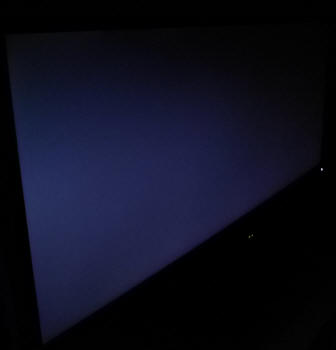
Above: View of an
all black screen from the side. Click for larger version
On a black image there is a characteristics IPS
white glow, but in normal working conditions this shouldn't present much
problem. In fact it was not as obvious as on some other IPS screens we've
tested. The above image was taken in a darkened room to demonstrate the white
wide angle glow when viewing a black screen. There is no A-TW polarizer on this panel which is rarely used
now in the market but was implemented on some older screens to improve the off
centre black viewing.
If you are viewing dark content from a close
position to the screen you can sometimes see this pale glow on parts of the
screen towards the sides and corners because of your proximity to the screen and
your line of sight. The edges of the screen are at an angle from your line of
sight which means you pick up this white glow to a smaller degree. This
disappears as you move backwards away from the screen where the line of sight
does not result in a wide angle view of parts of the screen and you can see the
screen largely from head on. This glow should
not be mistaken for backlight bleeding which would not disappear as you changed
your line of sight or angle of viewing.

Panel Uniformity
We wanted to test
here how uniform the brightness and colour was across the screen, as well as identify any
leakage from the backlight in dark lighting conditions. First of all
measurements of the luminance were taken at 36 points across the panel on a pure
white background. The measurements were taken using BasICColor's calibration
software package, combined with the NEC customised X-rite i1 Display 2
colorimeter. The below uniformity diagram shows the difference, as a percentage,
between the luminance recorded at each point on the screen, as compared with the
reference point of a calibrated 120 cd/m2. This is the desired level
of luminance for an LCD screen in normal lighting conditions, and the below
shows the variance in the luminance across the screen compared with this point.
It is worth noting that panel uniformity can vary from one screen to another,
and can depend on manufacturing lines, screen transport and other local factors.
This is only a guide of the uniformity of the sample screen we have for review.
The U2913WM
features a uniformity compensation feature which we will test here as well, but
first of all we left this setting off.

Luminance Uniformity
Uniformity of Luminance
Uniformity Compensation = Off
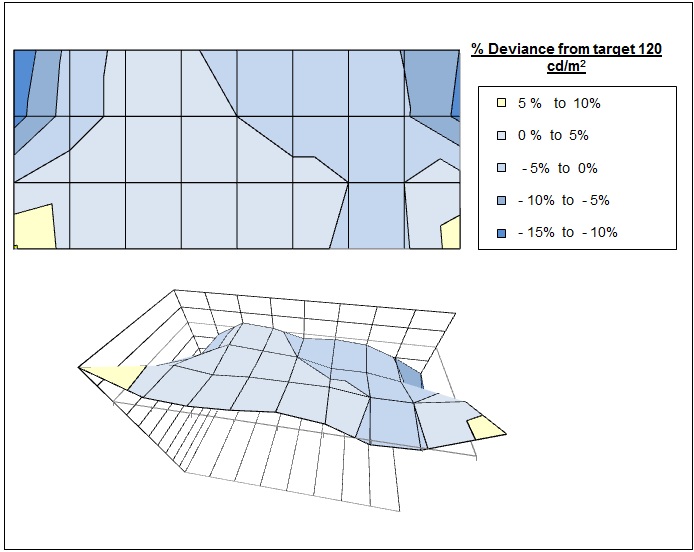
The luminance uniformity of the U2913WM was
very good on the whole, even without any uniformity compensation feature
active. The screen showed some deviance in the four corners. The top corners
were a little darker, down to 105
cd/m2
with a -14.3% deviance from the central point in the top left as the most
extreme example. In the bottom corners the screen was a little brighter,
ranging up to 134 cd/m2 maximum in the bottom left (+10.5%
deviance). Overall ~90% of the screen was within 10% deviance of the central
120 cd/m2 point which was very good really.

Uniformity Compensation Feature
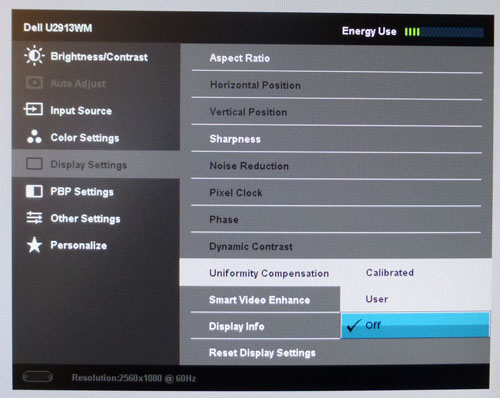
The U2913WM features a uniformity compensation
feature within the OSD menu as shown above. This isn't something Dell have
made much fuss of oddly, but it's a feature normally reserved for
pro-grade screens. We've seen similar technologies used on NEC and Eizo
screens in the past with some positive results. The Dell manual states:
"Uniformity Compensation adjusts different areas of the screen with respect
to the centre to achieve uniform brightness and colour over the entire
screen. For optimal screen performance, Brightness and Contrast for some
preset modes (Standard, Color Temp, sRGB) will be disabled when Uniformity
Compensation is turned On. When Uniformity Compensation is turned On, Energy
Smart cannot be activated. NOTE: Screen Uniformity performance is optimized
at default out of factory luminance setting."
There are
options available for "calibrated" and "user" as well as an off setting. The
calibrated option is supposed to represent a factory setup and as per the
manual this is apparently optimised when in the screens default setup and at
the default 50% luminance. The user mode isn't really talked about in the
U2913WM manual but we know from the U2713H manual that it was supposed to be "reserved for Dell approved user
calibration software settings". When we tested the U2713H we
couldn't see any options within the
calibration software of Dell Display Manager software to do anything related
to panel uniformity. We concluded that perhaps this was a feature not yet available but to be released
in a future software update. In fact we have since confirmed with Dell
engineers that the user feature was abandoned late in development on these
new UltraSharp screens and is not available, with no plans to make it
available. It should be removed really from the manuals and OSD menu which
Dell are looking at for future revisions.
Although the
manual states that the factory calibrated uniformity compensation mode is
optimised for use at the default 50% brightness, it should also offer
improvements in theory at other brightness settings. After all, who is going
to operate their screen at the high default luminance day to day? To start
with we left the screen set at our calibrated 120 cd/m2 setting
and measured the luminance uniformity again while in the "calibrated" mode:

Uniformity of Luminance
Uniformity Compensation = Calibrated
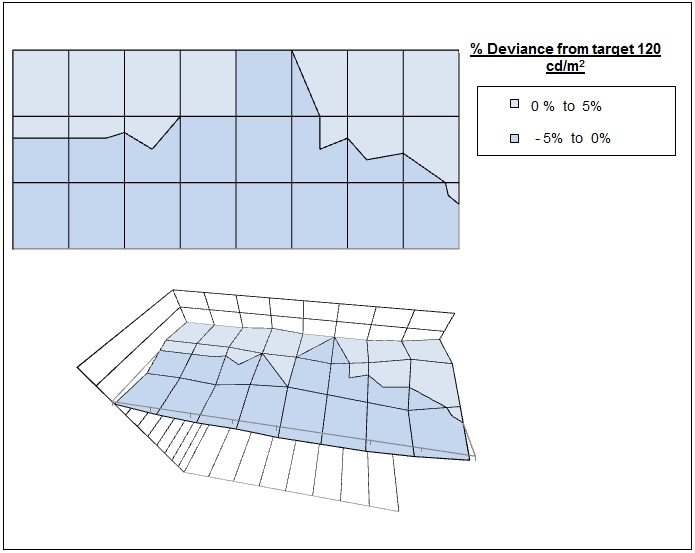
When we had
tested the feature on the U2713H we had found that it seemed to do nothing
at all, and didn't help to correct the fairly disappointing uniformity
variations for a screen of that type and market segment. However, on the U2913WM
we are pleased to say it really did help. As you can see from the above, the
uniformity, although pretty good really at default settings, was improved quite
a lot when the compensation feature was turned on. 100% of the screen was within
only 5% deviance of the central point which was excellent. Certainly a very
useful option here for anyone doing colour critical work or wanting to ensure
the most uniform luminance setup they can. The only slight downside of this
feature is that it impacts the static contrast ratio a little, dropping from the
default of ~1100:1 (when switched off) to 830:1 when switched on. This is a
similar trade-off seen on other competing technologies like NEC's ColorComp so
is to be expected.

Uniformity of Luminance
Uniformity Compensation = User
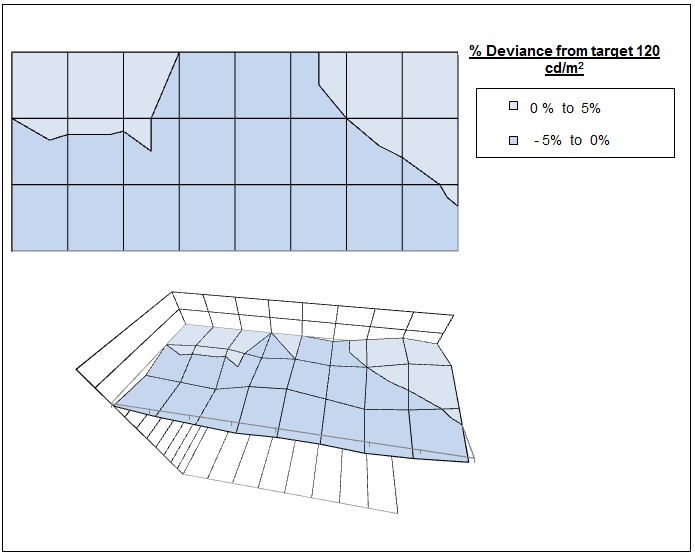
While we know this "user" mode was
abandoned late in development and shouldn't really be available as an
option, we thought we'd test the screen again to see what it did. The static contrast ratio remains as it was in the calibrated mode
at 830:1. As you can see from the above, the picture was pretty much
identical to the calibrated setting, providing a very good luminance
uniformity as before. It seems like this user mode has just been set up to
be the same as the "calibrated" mode, so you can choose either really, it
doesn't matter. Eventually on future revisions of the screen I suspect it
will be removed as an option from the OSD firmware.
Colour Temperature / White Point
Uniformity
We also
extended our tests in this area to establish how uniform the colour was
across the screen. We measured the white point (colour temperature) deviance
compared with a central point calibrated to our 6500k target. First of all
we carried out this test with the uniformity compensation feature turned
"off".

Uniformity of White Point / Colour
Temperature
Uniformity Compensation = Off
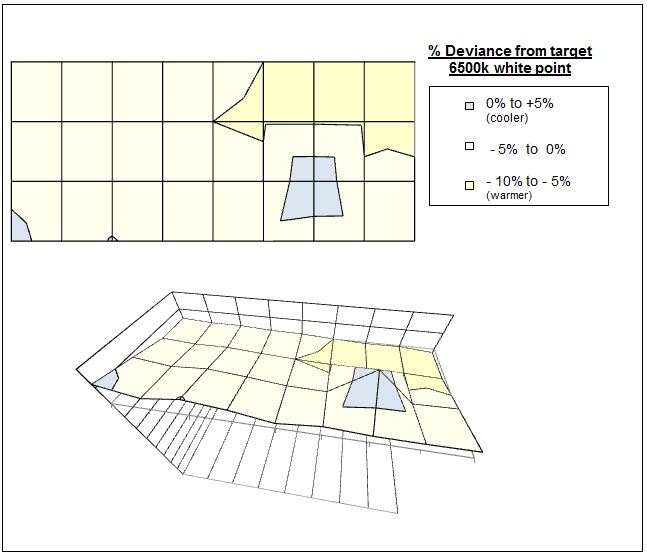
As you can see, the colour temperature was
very uniform across the panel with only small deviations across the screen.
There were a couple of areas where the white point was a little cooler
including the lower right hand region (7073k, 8.82% deviance) and bottom
left hand corner (6897k, 6% deviance). The rest of the screen was within 1 -
2% deviance which was great. There should be no issues with differing
colours across the screen as a result.

Uniformity of White Point / Colour
Temperature
Uniformity Compensation = Calibrated
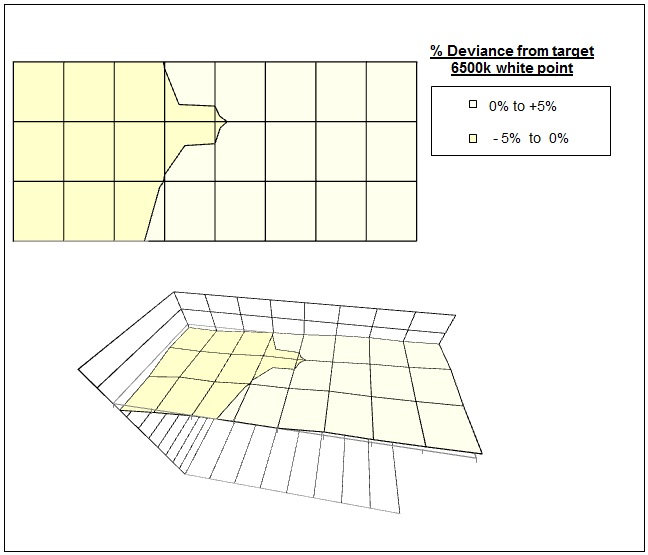
We then turned the uniformity feature back on
to 'calibrated' and ran the same tests. As you can see the results are even
better and the feature had helped correct the slight variations we'd seen
before. The whole screen was within only 2.5% deviance from the target 6500k
point which was great news.
Unlike the U2713H where the feature seemed to
do nothing, on the U2913WM it works well to correct the small differences we
see without the feature turned on. You do lose about 180:1 worth of contrast
ratio unfortunately, but that still leaves you with a useable static
contrast ratio of ~830:1 which is still very respectable for an IPS panel
anyway. If you're worried about uniformity of your luminance or colour
temperature
then this feature may well be useful.

Backlight Leakage
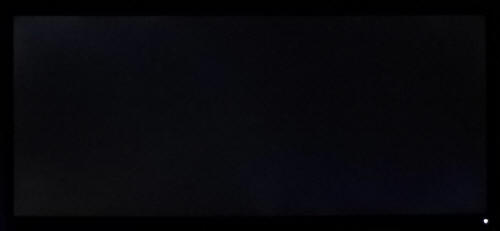
Above: All black screen in a darkened room. Click for larger version
As usual we also tested the screen with an all
black image and in a darkened room. A camera was used to capture the result.
There was no massively obvious backlight bleeding at all to the naked eye and the
uniformity looked pretty good, even in a darkened room. There was some clouding
noticeable in the corners, mostly the top left and the camera captured this as
well. This is not something which you should notice in practice though.

General and Office Applications

The U2913WM feature a massive 2560 x 1080 resolution which
offers something different which we haven't tested before. This gives you the
same horizontal resolution as a 27" / 30" screen, but only the same vertical
resolution as a smaller 24" model (or below). This means you don't get as much
room vertically as the widely available 27" models, but the horizontal
resolution is still more than enough for good side by side split-screen working.
In fact the U2913WM is designed to try and replace the need for dual screens of
a small size, so this would give you the same desktop resolution horizontally as
two 1280 x 1024 res screens, with a little bit more vertically as well in fact.
So resolution-wise, it does offer an interesting option, but personally I don't
think it's as well suited to office applications as a 2560 x 1440 or 2560 x 1600
res monitor, as you do miss some of the vertical room.
The pixel pitch of 0.265mm is small but very
similar to that of a 24" screen (0.270mm from a 16:10 format 24" screen). It is
a little bigger than the popular 27" 2560 x 1440 res models which have a pixel
pitch of only 0.231mm. As a result, text is a little bigger on the U2913WM and
so may be more comfortable for prolonged use or for those with weaker eye-sight.
Some users may still find the small text a little too small to read comfortably,
and I'd advise caution if you are coming from a lower res 19" or 22" screen for instance
where the pixel pitch and text are much larger. The image was very sharp and crisp and text was very clear.
The light AG coating is also a
very positive move when it comes to these kind of uses and we had been pleased
when Dell made this switch before with the U2713HM and U2713H models. The new lighter coating
ensures that white backgrounds of office documents looked good, and did not
suffer from the overly grainy and dirty feel of some other IPS panels
featuring heavy, aggressive AG coating - including the old U2711. It also remained free from the reflections you might experience from a
full glossy solution so seems to be a good half-way between the two. The
wide viewing
angles provided by the IPS panel technology on both horizontal and vertical
planes, helps minimize on-screen colour shift when viewed from different angles. The
default setup of the screen was very good really, even in the 'standard' mode,
with decent gamma, contrast and colour accuracy out of the box. The factory
calibrated sRGB mode was even better, and even provided a closer match to the
specific sRGB reference colour space.
There is a specific 'paper' preset mode available
within the OSD menu which makes the image darker and more yellow. This might be
useful to some for certain reading conditions, but with the wide range of
adjustments and modes available it should be easy enough to get an optimum setup
for your uses. Out of the box the luminance was
too high and so you will want to turn this down a fair amount to obtain a
setting comfortable to you in your lighting conditions. A setting of around 27%
brightness should give you a luminance
of ~120
cd/m2 out of the box. The brightness
control affords you a good range of adjustments as well, allowing you to go up
to ~313 cd/m2 and down as low as ~50 cd/m2.
Even those wanting to use the screen in low light conditions should find the
adjustment range more than adequate. Another thing to note while we are talking
about the brightness control is that the screen does not use
Pulse-Width modulation (PWM) to control backlight dimming and so those who
suffer from eye fatigue or headaches associated with flickering backlights need
not worry here. The screen is also free from the so-called "cross-hatching"
issue which some users noticed on the 27" U2713HM.
The screen does not suffer from the occasional buzzing issue either which is
good news, something which some users complained about with the U2713HM and
U2713H in some circumstances.
The screen offers a 4 port USB 3.0 hub which is
useful, especially with 2 ports located on the left hand edge for easy and quick
access. There is no card reader on this model though sadly, something
personally I've found useful on previous Dell models and on the recent U2713H. There was a
very good range of
ergonomic adjustments available which were all pretty easy and smooth to use.
The screen does not offer a rotation function though but that would be impractical at this
size anyway. The VESA mounting support may also be useful to some people. With
DisplayPort and DL-DVI both supporting the full 2560 x 1080 resolution you
should have a decent choice for your PC connectivity.

Responsiveness and Gaming
The U2913WM is rated by Dell as having an 8ms G2G response time which implies the use of
overdrive /
response time compensation (RTC) technology, used to boost pixel transitions
across grey to grey changes. There is no user control over the overdrive impulse
within the OSD menu and so we are reliant once again on Dell's factory setup. The
part
being used is the
LG.Display LM290WW1-SSA1 AH-IPS panel. Have a read about response time in
our
specs section if any of this is new to you.
Display Comparisons
The screen was tested using the chase test
in PixPerAn for the following display comparisons. As a reminder, a series of pictures are
taken on the highest shutter speed and compared, with the best case example
shown on the left, and worst case example on the right. This should only be used
as a rough guide to comparative responsiveness but is handy for a comparison
between different screens and technologies.

29" 8ms G2G
LG.Display AH-IPS
In practice the Dell U2913WM showed low
levels of motion blur and there was no obvious ghosting which was
good. Movement was pretty sharp although in some cases there was a slight dark
overshoot introduced which you can see more clearly in the second image on the
right above. This was nothing too severe but is caused where the overdrive
impulse is applied too aggressively or not controlled sufficiently. On some
other screens this is far more noticeable and it is only quite slight on the
U2913WM thankfully.

29" 8ms G2G
LG.Display AH-IPS

27" 8ms G2G
LG.Display AH-IPS

27" 6ms G2G
LG.Display AH-IPS

27"
6ms G2G LG.Display H-IPS
We have provided a comparison of the U2913WM above
against the three 2560 x 1440 resolution 27" Dell screens we have tested. The
U2913WM seemed to perform quite similarly to the
Dell U2713HM as you can see from the above with low levels of motion blur.
There was perhaps a little more noticeable overshoot on the U2913WM in practice
but it was quite minimal. The U2713H showed slightly slower response times with
a more noticeable blur, but freedom from any overshoot artefacts due to its less
aggressive overdrive impulse. The overshoot
was more pronounced on the
Dell U2711 and took the form of a dark trail as you can see above. Overall a
pleasing performance from the U2913WM and a decent response time suitable for
its target audience.

29" 8ms G2G
LG.Display AH-IPS

27" 5ms G2G
Samsung PLS (Trace Free = 40)

27" 5ms G2G
Samsung PLS (Response Time = Faster)

27" 12ms G2G
LG.Display H-IPS
We have provided a comparison of the U2913WM above
against 3 other popular 2560 x 1440 resolution 27" screens we have tested
which all use IPS (or the very similar PLS) panel technology. The U2913WM was
quite comparable to the PLS-based
Asus PB278Q and
Samsung S27A850D which was a positive result, both showing no obvious
ghosting and no obvious artefacts caused by the RTC impulse which was pleasing
at certain optimum settings. The
HP ZR2740w v2 was a little slower with a more noticeable blur to the image
in practice.

29" 8ms G2G
LG.Display AH-IPS

24" 7ms G2G
LG.Display AH-IPS

27" 5ms G2G
LG.Display AH-IPS (overdrive = medium)

27" 4ms G2G AU
Optronics AMVA (AMA = Premium)
We can also compare the U2913WM against a
few
other 27" models, this time with lower 1920 x 1080 resolutions. The
AOC i2757Fm and
Dell S2740L show a slightly slower performance in practice than the U913WM.
In the case of the Dell S2740L, a dark
overshoot is again introduced due to an aggressive overdrive impulse though. The
BenQ GW2750HM is a little different as it is based on a 1920 x 1080
resolution AMVA panel and not IPS technology like the others here. It was again
a little slower than the U2913WM and showed a dark overshoot again caused by the
aggressive overdrive impulse.

29" 8ms G2G
LG.Display AH-IPS

30"
7ms G2G LG.Display H-IPS

24" 6ms G2G AU
Optronics AMVA

24" 8ms G2G
LG.Display e-IPS

24"
6ms G2G LG.Display H-IPS
We can also compare the U2913WM with some of the
other Dell screens
we've tested here, this time in other sizes including the 24"
U2410 and U2412M and the 30" U3011 (soon to be replaced by the U3014
incidentally). The U2913WM is faster than the 30" U3011 with less blurring in
practice. The S2440L and U2412M were as responsive as the U2913WM but
while they may have fast
pixel transitions, the dark trailing overshoot is quite apparent.

29" 8ms G2G
LG.Display AH-IPS

24" 2ms G2G AU
Optronics TN Film + 120Hz (AMA = On)

27" 1ms G2G Chi
Mei Innolux TN Film + 120Hz (Over Drive = 0)

22" 3ms G2G Samsung TN Film + 120Hz
We've also included a comparison above against
three very fast 120Hz compatible screens we have tested. In all cases these
other screens are using TN Film panels and are aimed primarily at gamers.
Firstly there is a comparison against the
BenQ XL2420T. This showed very low levels of motion blur, but some dark
overshoot was introduced as a side-effect. The
Iiyama G2773HS was very responsive and even has a quoted 1ms G2G response
time. This showed very low levels of blur and had minimal issue with overshoot.
The
Samsung SM2233RZ performed very well in these tests and showed very low
levels of motion blur also. When 120Hz mode was enabled the overdrive artefacts
evident in 60Hz mode were almost completely eliminated, which is something we
have seen with the BenQ XL2420T as well.
While these pixel response tests show the U2913WM to
have fast transitions and low levels of motion blur with only slight
overshoot, there is something else going on as well here which can't be picked out by the camera. All of these other TN Film models are
running at 120Hz refresh rates, which allows for improved 120fps frame rates and
the support of
3D stereoscopic content as well. This can really help improve smoothness and
the overall gaming experience so these screens still have the edge when it comes
to fast gaming. From a pixel response point of view the U2913WM performed
very well, but there are some other areas you still need to think about when it comes
to high end gaming. It couldn't keep up with the very fast TN Film models with
120Hz support.
The responsiveness of the U2913WM was very good
overall and we were pleased with the results. It showed low levels of motion
blur and only small amounts of RTC overshoot in certain transitions. It was at a
similar performance to the U2713HM and offered a better gaming experience than
some of Dell's other screens which were more affected by the dark overshoot. The
ultra-widescreen format is also a very interesting option for gaming since it
provides a very wide field of view if your game supports it. This can really add
to immersion and your overall gaming experience if you play games which can
handle this very wide 21:9 aspect ratio. If not, the screen still supports a
decent range of aspect ratio options (discussed below) which is good news.

Additional Gaming Features
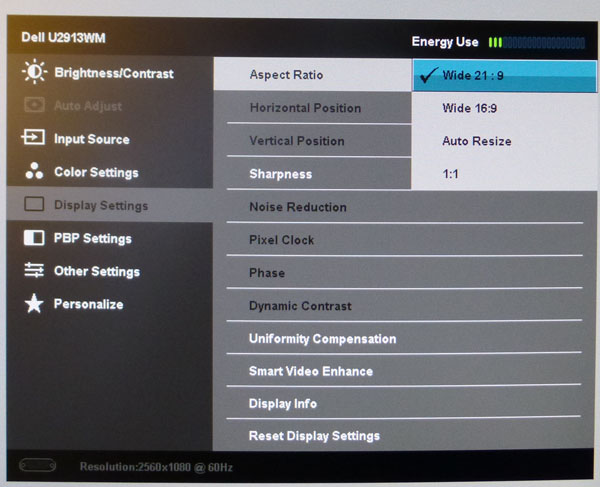
Aspect Ratio Control - The screen offers
four options within the OSD menu for hardware level
aspect ratio control. There are options to maintain the aspect ratio at
'wide 21:9' or 'wide 16:9' which users will hopefully be familiar with. These
will help maintain those specific aspect ratios for certain sources, stretching
the image to fill as much of the screen as possible and using black borders to
cover the sides (for 16:9 mode). It was good to see this specific 16:9 option
available as a lot of content is of course still based on this aspect ratio.
There is also then an option for 'auto resize' which
retains the source aspect ratio no matter what it is, and fills as much of the
screen as possible (black borders used where needed). This is particularly
useful as it will automatically detect the aspect ratio and maintain it. This
wasn't available on the U2713HM and so some aspect ratios such as 16:10 could
not be maintained at a hardware level. The U2713HM only had options for 16:9,
5:4 and 4:3 so anything other than those would not be handled by the screen. In
the case of the new U2913WM this is handled via the 'auto resize' option without
problem. The last option is for 1:1 pixel mapping which directly maps the source
resolution to fill only the required number of pixels. Again handy for those
wanting to maintain any source resolution and aspect ratio, without stretching
the image at all.
Preset Modes - There is a 'game' preset
mode available from within the preset mode menu. This seems to look quite
similar to the standard preset mode and it gives you access to the
dynamic contrast ratio if you want to use it. This mode might be useful if you want
to set up a specific mode to be different to your day to day normal use profile
as well.

Input Lag
We have written an in depth article about
input lag and the various measurement techniques which are used to evaluate
this aspect of a display. We have improved our method by adopting the SMTT
2 (now version 2.5.1) tool which is used to generate the results below. Please
see our full
input lag testing article for all the details.
Input Lag Classification
To help in this section we will also introduce a broader classification system
for these results to help categorise each screen as one of the following levels:
-
Class 1)
Less than 16ms / 1 frame lag - should be fine for gamers, even at high levels
-
Class
2)
A lag of 16 -
32ms / One to two frames - moderate lag but should be fine for many gamers.
Caution advised for serious gaming and FPS
-
Class
3)
A lag of more
than 32ms / more than 2 frames - Some noticeable lag in daily usage, not
suitable for high end gaming
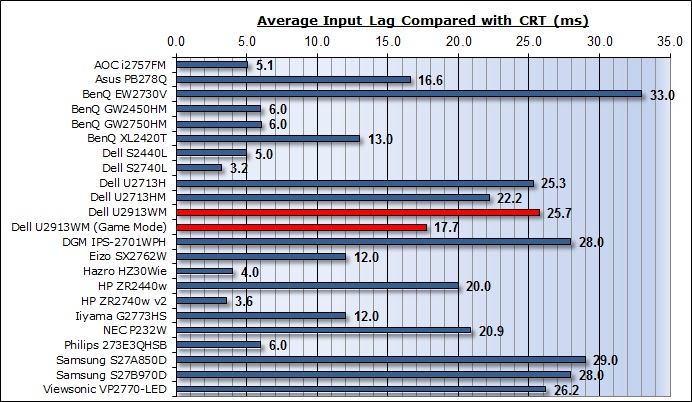
For the full reviews of the models compared here and the dates they were written
(and when screens were approximately released to the market), please see our
full
reviews index.
|
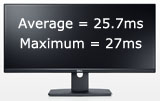
Standard Mode |
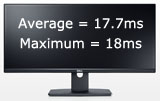
Game Mode |
 |

Class
2 |
We have provided a comparison above against other models we have tested to give
an indication between screens. In the default 'standard' preset mode the Dell U2913WM showed an average total display
lag of 25.7ms during this test, ranging up to 27ms maximum. Remember, this
represents a signal processing lag along with an element of pixel response time
and gives you an idea of the overall delay of the image compared with a
traditional CRT screen. This lag was not too severe, and at a similar level to
what we'd experienced recently with the U2713H (25.3ms). It represented a lag of just over 1.5
frames.
This was slightly slower overall than the U2713HM
(also tested using the same SMTT method). Prad.de have also tested the U2713HM
with their oscilloscope based method and identified a signal processing lag of
15.5ms and a further 7.1ms of response time accounted for to give them an
overall display lag of 22.6ms. We can probably assume that the U2913WM has a
very similar signal processing lag (around 15.5ms) which is probably related to
the internal scaler. The slightly higher overall display lag is probably down to
slightly slower response times but it is within a few milliseconds so nothing
massive.
We were pleasantly surprised though when we tested
the display lag again in the 'game' preset mode. As you switch to this mode the
screen seems to turn off for about 1 second as it makes the change. When in the
game mode the display lag was reduced quite nicely and was now measured with an
average of 17.7ms. This mode seems to be bypassing some of the internal
electronics and so was helping to reduce the lag for gaming needs. It was still
just over 1 frame delay but was a bit better than the standard mode at least. The lag of this screen has been categorised as CLASS 2
as detailed above and may be a little high for some very high end gaming. The
game preset mode helps and should be used if you're playing fast games and need
the absolute lowest lag you can get from the display.

Movies and Video

The following summarises the screens performance
in video applications:
-
29"
screen size makes it a reasonable option for an all-in-one multimedia screen,
but being quite a bit smaller than modern LCD TV's of course. As far as
desktop monitors go it is at the large end.
-
21:9
aspect ratio is more well suited to widescreen movies and videos than some
other aspect ratios like 5:4 and 16:10. Some content is specifically designed
in this format which is obviously a great benefit as the screen is completely
filled with the image and there are no borders needed. This is where the
U2913WM comes into its own for movies. For other content, a lot of it is based
on a 16:9 aspect ratio which is pretty common for TV formats especially. As a
result, if you view that content on this screen then you will end up with
borders down the left and right hand sides. Not a problem as the screen
supports hardware level aspect ratio control, but it isn't as visually
pleasing as just using a 16:9 format screen to start with. For movies and
video, you need to think about what formats you are going to want to be
watching when thinking about these new 21:9 aspect ratio screens.
-
2560 x
1080 resolution can support full 1080 HD resolution content.
-
Digital interfaces supports HDCP for any encrypted
and protected content.
-
Good to
see that both DVI and DisplayPort are provided on this model, allowing you to connect
your PC over DVI, and leave the DisplayPort free for an external device potentially.
Also good to see HDMI included as that is very popular and
widely used for external DVD and Blu-ray players.
-
DVI and
DisplayPort > Mini DisplayPort cables included in the box, but no "normal"
DisplayPort or HDMI cables included.
-
Light
AG coating does not cause issues with reflections which glossy coatings can.
-
Wide brightness range adjustment possible from the display, including high
maximum luminance of ~313
cd/m2 and a good minimum luminance of
~50 cd/m2. This should afford you very good control for different
lighting conditions.
-
Black
depth and contrast ratio are excellent for an IPS panel at 1011:1 after
calibration. Shadow detail in darker scenes should not be lost.
-
Dynamic contrast ratio available but its practical use is questionable given
the slow transitions in darker content changes. IT's there to experiment with
though if you like DCR as a feature. We would suggest using the game preset
mode as for some reason the movie mode carries a weaker static contrast ratio
which isn't advisable.
-
'Movie' preset mode available but impacts contrast ratio a lot so should
probably be avoided.
-
Smart
Video Enhance Feature available from the OSD menu. This is a new feature we've not seen on other Dell
screens before. The feature automatically detects video (motion) in any window
on the screen, and applies enhancements to the video. Only the video window is
enhanced. Two different enhancement settings are available as well, those being
"Movie"- suitable for movie or multimedia video clips, and "Advance" - User
adjustable setting. This setting basically features tweaked (or customisable in
the case of the "advance" option) settings for contrast, sharpness, offset, hue
and saturation. It is designed to only impact video content on the screen so may
be a useful feature to some, if you want to change the appearance of your video
windows without impacting on the overall screen appearance.
-
Good
pixel responsiveness which should be able to handle fast moving scenes in
movies without issue.
-
Very
good range of hardware aspect ratio options which should be able to scale and
handle external devices easily. Nice to see an "auto" mode and 1:1 pixel
mapping included
-
Wide
viewing angles thanks to IPS panel technology meaning several people could
view the screen at once comfortable and from a whole host of different angles.
On darker content the IPS white glow
may present a bit of a problem if viewed from wider angles.
-
Good
range of ergonomic adjustments available from the stand. Should be easy to
obtain a comfortable position for multiple users or if you want to sit further
away from the screen for movie viewing.
-
No
noticeable backlight leakage, and none from the edges which is
good. This type of leakage may prove an issue when watching movies where black
borders are present but it is not a problem here.
-
No
integrated stereo speakers on this model or audio connections but it is
compatible with Dell's SoundBar.
-
Picture By Picture (PbP) available if needed but not Picture In Picture (PiP).
-
For
PAL sources, we have tested the screen and confirmed it
will support
the full native resolution of 2560 x 1440 at 50Hz refresh rate.

Conclusion
The Dell U2913WM was an interesting screen to
test. At first I'll admit the screen size and aspect ratio felt strange but it's
surprising how quickly you get used to it. Obviously this is going to be a key
part of whether you consider purchasing this screen but it does provide some
interesting benefits for side by side office working, movies and games. If you
are going to use the screen for a lot of games or movies which run at this very
wide aspect ratio then it really is an impressive solution. On the other hand,
keep in mind that a lot of content is based on other aspect ratios, including
the popular 16:9 format, and so you may have to live with borders in many cases.
We were pleased that Dell had kept many of the
features which we've seen from other UltraSharp range screens and not trimmed it
back into a more mainstream model. The wide range of adjustments from the stand
and decent interface options were kept, and it was nice to see some of the
extras like touch-sensitive buttons, USB 3.0 ports, factory calibration and
uniformity compensation.
Out of the box the screen had a very decent set
up, with a good gamma, contrast and colour accuracy. The sRGB mode was even
better and this screen should be fine for most users even without the need for
manual calibration. The contrast ratio was excellent from the screen as well,
the best we have seen in fact from an IPS panel. Backlight range was very good
and it was pleasing to see another Dell screen without Pulse Width Modulation
use for dimming. The screen of course offered the overall performance benefits
of the popular IPS technology, and we were pleased with the overall picture
quality and viewing experience. The responsiveness was also very good and we
were pleasantly surprised by the reduced input lag from the 'game' preset mode.
This was still a little high for some very fast gaming but nothing too severe.
The panel uniformity was another pleasant surprise, being actually pretty good
by default and even having a uniformity compensation feature which worked very
well. Glad to see it functioned properly here unlike what we'd seen from the
U2713H recently. The DCR worked to a degree but is probably impractical in
normal use due to the slow transitions. Something unfortunately very common with
these DCR features.
Overall we were left impressed by the U2913WM. The
performance was actually very impressive in most regards, and the main
consideration really is whether you want the wide aspect ratio or not for your
uses. The screen retails for
�479 GBP (inc VAT) at the moment which puts it at the same price as the Dell
U2713HM. Certainly an interesting alternative to consider.
|
Pros |
Cons |
|
Good default setup and factory
calibration, including excellent contrast ratio for an IPS panel |
Ultra-wide aspect ratio may
not be ideal for some games / movies which are built for 16:9 or other
aspect ratios |
|
Good pixel response times |
Dynamic contrast ratio
probably impractical due to slow transitions |
|
Uniformity compensation
feature works well |
Input lag perhaps still a
little high for very fast gaming, even in 'game' preset |
|
 |
If you have enjoyed
this review and found it useful, please consider making a
small
donation to the site. |
